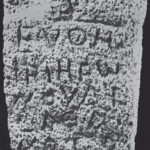| Artefact ID | 1287 |
| TM ID | TM 701030 |
| Findspot (DEChriM ID) | 68 (al-Filusiyya) | Class | Funerary element, Textual |
| Material | Stone |
| Writing medium | Inscription |
| Text content | Subliterary |
| Language | Greek |
| Description | SEG LIX 1878: Epitaph of Heron, 20 years old. Dahari & Di Segni 2009, no. 6: Anthropomorphic stela of beach-rock of slightly tapering rectangular shape, surmounted by a head; a tang or tapering end at the bottom is lost. H. 75 cm; W. at the top 30 cm; Th. 11 cm. The head has no face but bears a large Jerusalem cross. Remains of red paint are barely visible on the head and in the script. The head is separated from the body by a horizontal line, underneath which is engraved a monogrammatic cross [staurogram]. The epitaph is engraved below, separated by a double horizontal line. The surface of the stone is rough and the letters are irregular, mostly round except for the square epsilon. Same consolatory formula as in the other steles sharing the same provenance – a combination restricted to the northern coast of Sinai (el-Huweinat and el-‘Arish) according to ed.pr.: εὐμοίρει, εὐψύχει, οὐδεὶς ἀθάνατος, “fare thee well, be of good courage, nobody is immortal”, accompanied by the name of the deceased in vocative. Here is lacking the usual εὐψύχει. The ed. remark that the text of this epitaph is similar with SEG XXVIII 1459 but the tombstone is completely different; they suggest that it was used as a model by an illiterate stonecutter. |
| Selection criteria | Christian terms/formulas/concepts, Christian symbols/gestures/isopsephy |
| Date from | 350 |
| Date to | 499 |
| Dating criteria | Phrasing and palaeography point to 4th-5th c. according to ed. pr. |
| Absolute/relative date | Relative date |
| Archaeological context | SEG LIX-1873-1882: One of the ten anthropomorphic stelai acquired in the antiquities market in the 1970s by the Israel Museum in Jerusalem and the Israel Antiquities Authority; returned to Egypt in 1993; all stelai come from the Byzantine nekropolis at el-Huweinat 2 km south of Ostrakine (east of Lake Sirbonitis = Sbakhat el-Bardawil; northern Sinai). |
| Accession number | Formerly: Jerusalem, Israel Antiquity Authority 4479 a. Returned to Egypt in 1993 (present location unknown). |


 Json data
Json data




